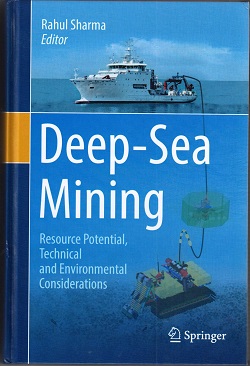 The title of this book is something of a misnomer; if and when deep-sea mining might ever be undertaken are still open questions. Notwithstanding, the book gives a useful snapshot of the current state of play and should be of interest to individuals and organisations involved.
The title of this book is something of a misnomer; if and when deep-sea mining might ever be undertaken are still open questions. Notwithstanding, the book gives a useful snapshot of the current state of play and should be of interest to individuals and organisations involved.
Part one deals with the nature, distribution and resource potential of deep-sea minerals, and will be the section of most interest to geologists. An authoritative overview of manganese nodules is patchy in detail. For example, it is mentioned that whether or not nodules become ‘economically interesting’ depends on their relationship to the calcium carbonate compensation depth, water depth, surface bioproductivity, sedimentation rate, sediment type, benthic activity, near bottom currents and local microtopography. Well, yes, but it would have been useful to discuss how these processes work and interact.
An overview of Co-rich ferromanganese crust deposits is dealt with well by an acknowledged authority in the field. One aspect that could have been covered more fully is the regional compositional variability of the deposits - surely of interest to future deep-sea miners. A concise and authoritative account of work on massive sulphides could have gone into more detail on exploration, whilst a chapter on phosphorites reviews mostly old material - probably because not much recent work has been done in comparison with other marine minerals.
The second part deals with mining concepts, beginning with geotechnical considerations that might be taken into account in the design of deep-sea mining systems. Unfortunately, a chapter reviewing historical developments and various proposed mining systems repeats the erroneous statement that the first nodules to be recovered from the Indian Ocean were by the R V Gaveshani in 1981 – they were actually first recovered much earlier than this.
Part three deals mainly with metallurgical processing of nodules. Some economic models for nodule utilization put processing at more than 50% of the total cost, so advances in this field could substantially affect the overall profitability of deep-sea mining.
Part four deals with environmental aspects of deep-sea mining - possibly the most contentious aspect of the subject. Of the most potentially serious environmental impacts of deep-sea mining are the destruction of marine organisms and the development of sediment plumes. The section reviews some Japanese work in this field, as well as taxonomic problems, the background to and development of an environmental management plan for deep-sea mining, international regulating agencies and the crafting of seabed mining ecosystem based management. This comprises only a limited number of aspects of what is a very complex subject, which really needs a book of its own.
Reviewed by David Cronan
DEEP SEA MINING by Rahul Sharma (ed) 2017. Published by Springer International, 535pp. ISBN: 978-3319525563 (hbk). List price: €142.79. W: www.springer.com